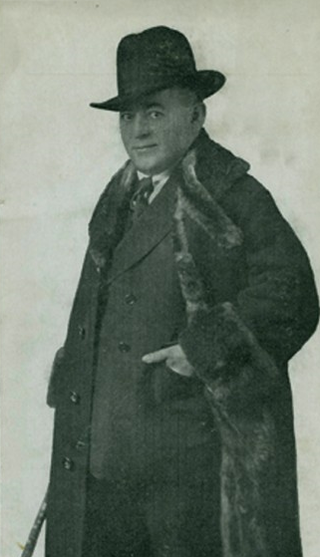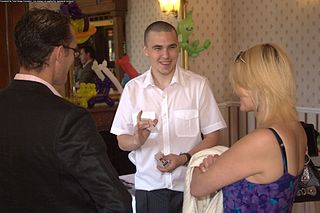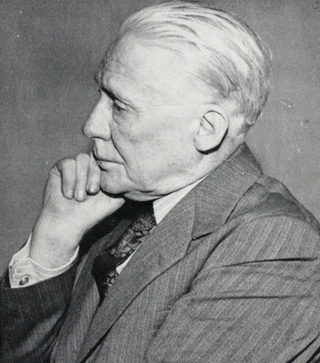Related Research Articles
Sleight of hand refers to fine motor skills when used by performing artists in different art forms to entertain or manipulate. It is closely associated with close-up magic, card magic, card flourishing and stealing. Because of its heavy use and practice by magicians, sleight of hand is often confused as a branch of magic; however, it is a separate genre of entertainment and many artists practice sleight of hand as an independent skill. Sleight of hand pioneers with worldwide acclaim include Dan and Dave, Ricky Jay, Derek DelGaudio, David Copperfield, Yann Frisch, Norbert Ferré, Dai Vernon, Cardini, Tony Slydini, Helder Guimarães and Tom Mullica.

Card manipulation is the branch of magic that deals with creating effects using sleight of hand techniques involving playing cards. Card manipulation is often used in magical performances, especially in close-up, parlor, and street magic. Some of the most recognized names in this field include Dai Vernon, Tony Slydini, Ed Marlo, S.W. Erdnase, Richard Turner, John Scarne, and Ricky Jay. Before becoming world-famous for his escapes, Houdini billed himself as "The King of Cards". Among the more well-known card tricks relying on card manipulation are Ambitious Card, and Three-card Monte, a common street hustle also known as Find the Lady.
A trick deck is a deck of playing cards that has been altered in some way to allow magicians to perform certain card tricks where sleight of hand would be too difficult or impractical.
The Ambitious Card, or Elevator Card, is a magic effect in which a playing card seems to return to the top of the deck after being placed elsewhere in the middle of the deck. This is a classic effect in card magic and serves as a study subject for students of magic. Most performing card magicians will have developed their own personal Ambitious Card routine.

Cardistry is the performance art of card flourishing. Unlike card magic, cardistry is meant to be visually impressive and appear very hard to execute.

David Frederick Wingfield Verner, better known by his stage names Dai Vernon or The Professor, was a Canadian magician.

Max Malini was a magician who at his peak performed for several US Presidents and at Buckingham Palace, receiving gifts from monarchs across Europe and Asia. Many magicians, such as Dai Vernon and Ricky Jay, have held him in high esteem for his skill and bold accomplishments.
This is a glossary of conjuring terms used by magicians.
This timeline of magic is a history of the performing art from B.C. to the present.
Spelling Bee may refer to one of several card tricks that revolve around the spelling of card types, audience member names, or words suggested by the audience. Many make use of decks prepared in advance in order to provide the illusion of spelling card names in a particular sequence. Jean Hugard's Encyclopedia of Card Tricks lists a number of such spelling-based tricks, many of which are considered to be self-working.
Howard Schwarzman was an American magician, card manipulator, sleight of hand expert, and trick inventor. Considered a "living legend" in the Eastern United States magician community, he was best known as a columnist within the magician trade press, and an importer of very rare tricks from outside the United States.

The Expert at the Card Table, is an extensive book on the art of sleight of hand published in 1902 by S. W. Erdnase, a pseudonymous author whose identity has remained a mystery for over a century. As a detailed manual of card sharps, the book is considered to be one of the most influential works on magic or conjuring with cards.

Close-up magic is magic performed in an intimate setting usually no more than 3 meters from one's audience and is usually performed while sitting at a table.

Chink-a-chink is a simple close-up magic coin trick in which a variety of small objects, usually four, appear to magically transport themselves from location to location when covered by the performer's hands, until the items end up gathered together in the same place. Variations, especially the Sympathetic Coins also known as Coins-n-Cards, have been performed since the 1800s. Popular modern variations are Shadow Coins and Matrix. A variation using playing cards as the objects is known as Sympathetic Aces.

Jean Hugard was an Australian professional magician.

Lewis Jack Ganson was an English magician who became one of the most prolific writers in magic, going on to write and edit more than sixty books on the subject.
Frederick Braue[pronounced BROW-ee] was an American journalist notable for his contribution to the field of card magic. He was a semi-professional magician, specializing in card magic, of which he was a master.
Walter Irving Scott was an American musician, cardsharp and amateur magician. His glowing reputation among magicians and card men revolves around his time as a card cheat and a single demonstration of sleight-of-hand to some of the era's best magicians in New York in 1930. He lived out his last years in Rhode Island as a music teacher. Scott spent his formative years perfecting several difficult sleights of card manipulation in order to work as a cardsharp in card games throughout America. He participated in several different types of swindles and hustles. Eventually turning to a music career he was asked to perform one more demonstration. This single event created a legend within the magic community that continues to this day.

Lawrence Grey was an English magician known for his card tricks. He also worked as an occasional actor and is known for voicing Bill the Lizard in Walt Disney's Alice in Wonderland.

Bruce Cervon was an American magician who was best known for his close-up magic, both through performance and invention. He published a series of books and helped to create a permanent record of the magic of Dai Vernon through The Vernon Chronicles, Dai Vernon's Ultimate Secrets of Card Magic, and Bruce Cervon's Castle Notebooks.
References
- ↑ Hugard, Jean; Frederick Braue (1974). "The Secret Lifts". Expert Card Technique: Close-up Table Magic . Dover Publications. p. 3. ISBN 0-486-21755-8.
- ↑ Vernon, Dai (March 1980). "The Vernon Touch". Genii. Vol. 44, no. 3. p. 25.
- ↑ Neve, Richard. The Merry Companion. London: Printed for H. Tracy, 1721. Print.
- ↑ "Double Lift". Conjuring Credits. Retrieved 2017-12-28.
- ↑ Ponsin, J. -N. Nouvelle Magie Blanche Dévoilée. Genève: Slatkine, 1980. Print.
- ↑ Hilliard, John Northern, Carl Waring Jones, Jean Hugard, and Harlan Tarbell. Greater Magic; A Practical Treatise on Modern Magic. Minneapolis: C.W. Jones, Priv. Print. for Professional & Amateur Magicians, 1938. N. pag. Print.
